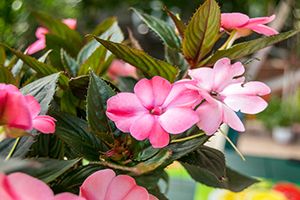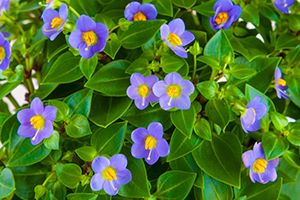 |
| Photo: Pixabay |
Cat-Safe Flowers
Today is St. Gertrude's Day, the patron saint of cats (although she's always eclipsed by that man). In her honor, why not give or plant some flowers that are safe for your cat to nibble?
Whether you're assembling a spring bouquet or planting your garden, you want to make sure that the flowers and plants you choose won't harm your cats. That's where the ASPCA's list of plants that are toxic and non-toxic to cats comes in handy. Access the full list at that link, but here are some selected flowers that will get you started. USDA hardiness zones are included, where available. (Zone recommendations vary widely between sources, so consult a local garden shop or master gardener if you're uncertain about the suitability of a plant for your own garden.)
If you run a garden shop, you can consult the ASPCA's list to make your customers aware of which plants are safe around their feline companions. Florists? These are flowers that are safe to include in your arrangements if your customer will be taking a bouquet to a friend or loved one who has a cat. There's an extra service you can offer to your customers!
The popular Gerber Daisy, Gerbera jamesonii, is also known as the Barberton Daisy, Veldt Daisy, African Daisy, or Transvaal Daisy. It's actually a perennial herb that comes in many colors and forms, courtesy of its many hybrids. They will grow year-round in zones 8-11, and in any climate during spring and summer.
The Camellia (Camellia japonica), also known as the Peony Camellia or Japanese Camellia, is also safe around cats. There are more than 2,000 cultivars of this plant, and its flowers can be various shades of pink, white, or speckled. These are winter-hardy in zones 7-10, while some cultivars of camellia will also survive in zone 8.
Coral Bells, Heuchera sanguinea, is native to Mexico and the American Southwest. Its flowers are deep pink to red, depending on the cultivar, and have a sweet fragrance. Also depending on cultivar, it can grow from 8 to 18 inches tall. This plant is hardy outdoors in zones 4-8 and attracts both bees and hummingbirds.
Coral Bells, Heuchera sanguinea, is native to Mexico and the American Southwest. Its flowers are deep pink to red, depending on the cultivar, and have a sweet fragrance. Also depending on cultivar, it can grow from 8 to 18 inches tall. This plant is hardy outdoors in zones 4-8 and attracts both bees and hummingbirds.
Cape Primrose, one of the Streptocarpus genus, has many cultivars yielding a wide range of colors: pink, white, violet, lavender, and variegated like the one shown here. There are even societies and online forums of people devoted to the various cultivars of these flowers. Hardy in zones 10-11. If grown indoors, place them in a sunny window to enjoy flowers for up to 10 months of the year.
This type of impatiens is known as Buzzy or Busy Lizzie or Patient Lucy, and is in the Balsaminaceae family. There are more than 1,000 species of impatiens that come in various colors. They have medicinal properties and are even an ingredient in the Bach Rescue Remedy tincture. Hardy in zones 10-11, where it is a perennial.
Blue Marguerite, also known as Felicia or Blue Daisy, has the botanical name of Felicia amelloidis. It's a perennial evergreen plant native to South Africa, but has been cultivated in Europe since the mid-1700s. Cold hardy in zones 8-11, it is easy to care for and is a perennial in zones 10-11, growing up to 2 feet tall and flowering throughout the summer and fall seasons.
The striking and popular Snapdragon, Antirrhinum majus, is hardy in both hot and cold temperatures. Native to the Mediterranean region, it can be an annual, biennial, or perennial, flowering from spring to fall. Grow it from seeds or cuttings. This popular plant is also known as Lion's Mouth, Toad's Mouth, Rabbit's Mouth, Calf Snout, Bonny Rabbits, and Lion's Snap. It can grow up to 2 or 3 feet tall as a perennial in zones 7-10, or as an annual in other temperate regions, but it will not withstand frost.
Bachelor's Button, also known as Cornflower or Bluebottle, has the botanical name of Centaurea cyanus. These European wildflowers have been cultivated to produce flowers in white, pink, purple, and lavender. Hardy in zones 2-11, they bloom from May through July and grow to around 3 feet tall.
A popular addition to many bouquets is Baby's Breath or Maiden's Breath. This more open form of it is Gypsophila elegans, often included in mixtures of wildflower seeds. An annual, it will grow in zones 3-10, but the plants only live for 5-6 weeks. If you plant seeds for it every few weeks, you'll have continuous blooms in your garden.
If you're worried about using Baby's Breath, try Alyssum instead. Alyssum comes in over 100 varieties in yellow, white, pink, or purple and is in the Brassicaceae family. These prefer cooler temperatures and are hardy in zones 5-9 as a ground cover. Not terribly heat-tolerant, however. They grow up to around 6 inches tall, but spread around 9 inches.
Gloxinia perennis, also known as Canterbury Bell, has purple or lavender flowers that smell of mint...but they don't bloom until mid-summer. Plant this perennial in your garden in spring, and look for these lovelies in July. Native to Central and South America, it does best in zones 9-10. Plants get around 3 feet tall.
Also in the African violet family is Cyrtudeira (Episcia reptans), which is native to Central and South America. Other names for it include Flame African Violet, Frosty, Flame, Lady Lou, Red African Violet, or Acajou. This perennial has stunning leaves and tiny red flowers. Usually kept as a houseplant, these will survive outdoors in zones 10-11. They'll grow to about 8 inches tall and bloom in both spring and summer.
Because there are so many flowering plants on the ASPCA's list, this subject matter will be continued in later posts. I don't want to overwhelm you with too much information at once! These first 21 are a lovely assortment of colors, types, heights and textures of flowers.
Once all these posts are done, you may just be seeing them all compiled into a book about this. Let me know in the comments below if such a book would be of interest to you!
Sources include the ASPCA site linked to above as well as the websites for Wikipedia, Backyard Gardener, Plant Lust, Dave's Garden, Missouri Botanical Garden, Gardenia.net, Gardener's HQ, Gardening Knowhow, and Candide.
Images above are from the ASPCA site of toxic and non-toxic plants.





























No comments:
Post a Comment